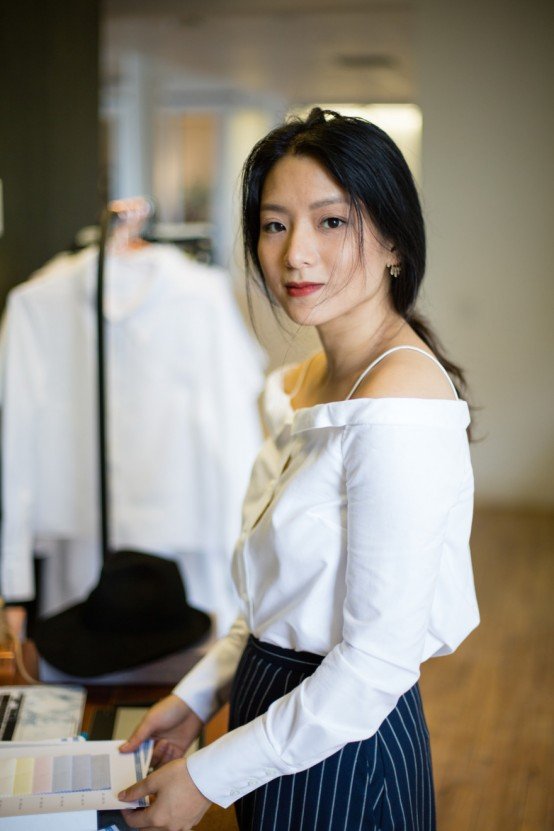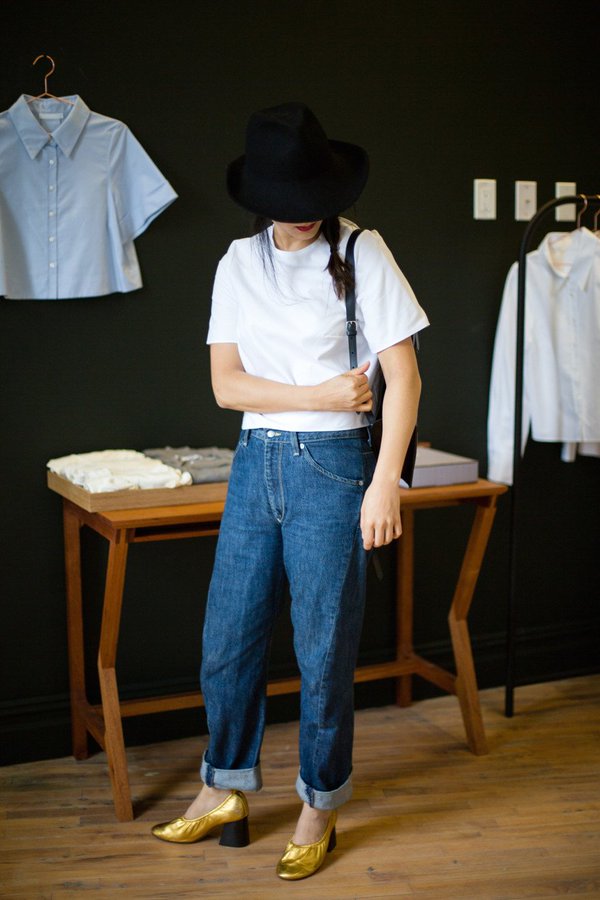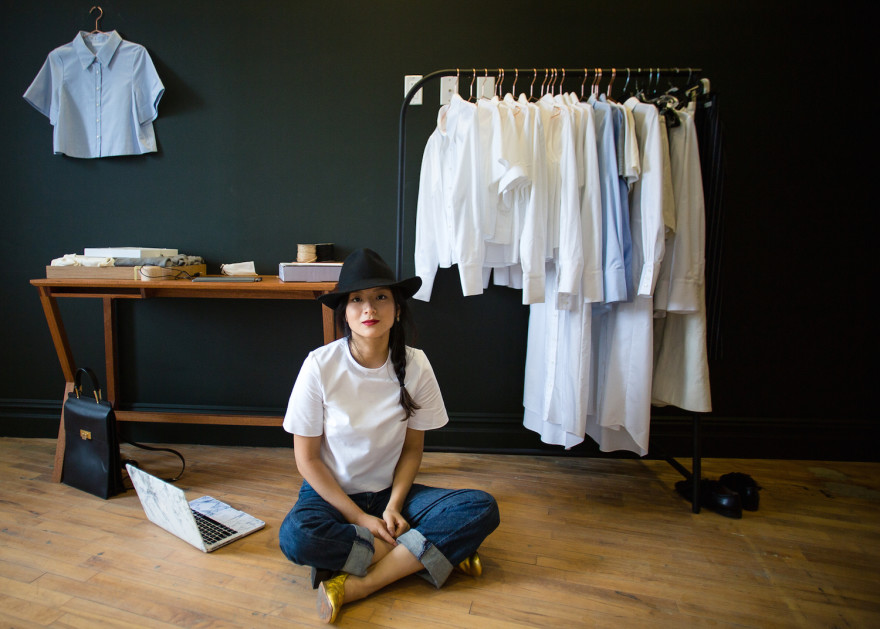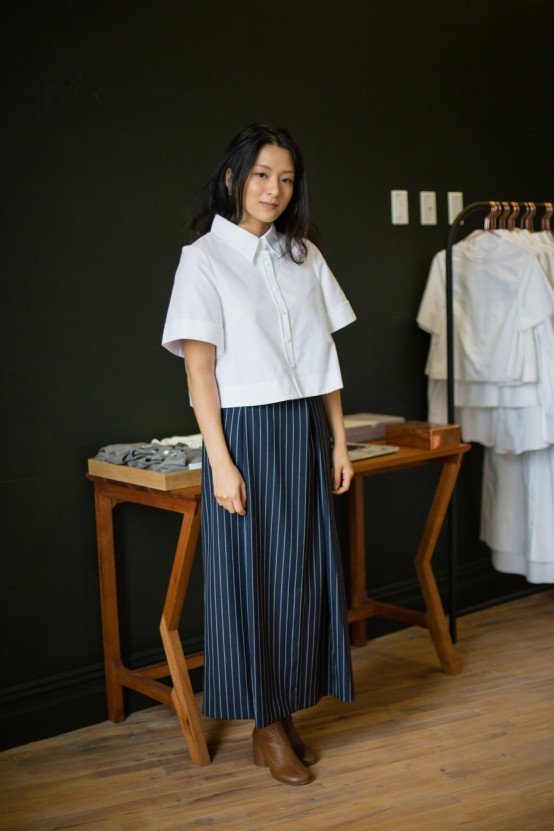 Most of us would count ourselves lucky having the opportunity to pursue one of our dreams for a living, right? Designer Alice Wang has done it not once, but three times. She cut her teeth pursuing her dream to work in film. Straight off the back of graduating in Film at Yale, she started working for Iranian-American screenwriter Massey Tadjedin, whose directorial debut starred Eva Mendes, Keira Knightley and Sam Worthington. And her film credentials don’t end there. After working freelance on music videos and short films, she met Lena Dunham and worked with her on her first feature length film, Tiny Furniture, helping take it to South by South West and the MoMA. A stint assisting Madonna shortly followed before she transitioned into interiors and design under Ian Schrager, one-half of the duo behind Studio 54 and the Edition group.
Most of us would count ourselves lucky having the opportunity to pursue one of our dreams for a living, right? Designer Alice Wang has done it not once, but three times. She cut her teeth pursuing her dream to work in film. Straight off the back of graduating in Film at Yale, she started working for Iranian-American screenwriter Massey Tadjedin, whose directorial debut starred Eva Mendes, Keira Knightley and Sam Worthington. And her film credentials don’t end there. After working freelance on music videos and short films, she met Lena Dunham and worked with her on her first feature length film, Tiny Furniture, helping take it to South by South West and the MoMA. A stint assisting Madonna shortly followed before she transitioned into interiors and design under Ian Schrager, one-half of the duo behind Studio 54 and the Edition group.
Today her world is consumed by Uniforme, the genius why-didn’t-I-think-of-that label she launched last year dedicated to, well, uniform dressing and quality, seasonless design. Considering the ubiquity of all things paired back and minimal over the past few years, you’d think we’d be spoilt for choice with brands that offer, cool technically-minded pieces that will last you a lifetime but don’t cost the earth. The reality is more of a choice between the likes of Cos and Whistles on the high street and, well, the big guns. In rejecting the whole longevity-means-expensive thing in lieu of something more accessible, Wang hit a goldmine with her brand of essentials for the Celine, Rosetta Getty and The Row crew.
In many ways, I’m the epitome of her customer. Looking back, I can honestly say that used to be a through-and-through hot mess when it comes to my wardrobe and shopping habits – and that’s putting it lightly. I always thought of myself as a smart shopper, when in actual fact the reality was completely different. You’ve probably heard it before: a wardrobe full of clothes but nothing to wear. It has taken the last few years of running a business – and quite frankly, not having the time or inclination to spend on superfluous purchases – that has made me realise just how important it is to have working pieces that you can rely on to make you feel and look polished on those days you’re feeling less than. That’s what makes her pieces so special. At Uniforme, a shirt isn’t just a shirt. Don’t get me wrong, all the key tenants are there, but Alice has a way of making it look and feel fresh and contemporary. Honestly, in my eyes she can do no wrong. Here she reveals all about her less-than-average career journey, breaks down where her love of uniform dressing began and talks honestly about the old shopping habits that inspired her to make a change.
ON FEELING LIKE AN OUTSIDER & TURNING TO FILM: Growing up, I felt very much like the odd one out. I found respite in escapism – reading and writing fiction. In middle school, I found a VHS tape of Todd Solandz’s Welcome to the Dollhouse and discovered the world of American independent film. Experiencing outsider films gave me a sense of identification, of connection. I was very academically minded and thought I might study cognitive science or English literature when I went to college, but I decided to follow my heart and ended up majoring in Film Studies at Yale. My senior year, I wrote a thesis paper and made a short film.
HER NOT-SO-AVERAGE FILM CAREER (& WORKING WITH LENA DUNHAM!): When I first moved to New York, I worked in film production. I assisted a writer/director, Massy Tadjedin, who remains a dear friend and mentor to this day. Then, I worked freelance, as a production coordinator or producer on small shoots for commercials, music videos, and short films. I had a job as a researcher for Todd Haynes on his HBO miniseries Mildred Pierce. I had the amazing experience of working on Lena Dunham’s first feature length film, Tiny Furniture too. It was such a small production that we were all playing so many roles on set. We premiered the film at South by Southwest. The film was picked up by IFC, and there was an incredible premiere at MoMA.
ON ASSISTING MADONNA: Working on Tiny Furniture was a thrill, but still I didn’t feel fulfilled in the way I had expected. I thought that when I played a critical part in a project that achieved some level of success, I would suddenly feel different. Around that time, Madonna was looking for a new personal assistant so when I was offered the job, it was an easy decision to take that opportunity and explore a world outside of independent film. She has her hands in so many projects – she was in the post-production process for W.E., a beautiful film that she wrote, directed and produced. And then she was writing a new album; putting together a tour and her Superbowl performance; managing her nonprofit which supports girls education in Malawi; and working on fashion and fragrance projects – just the ultimate polymath, with the most rigorous work ethic and drive – and always, ambition. You know, and all while having a family and raising children as a single working mother! There’s no trick to having it all – it requires an intense degree of dedication, focus and work.
Growing up, I felt very much like the odd one out. I found respite in escapism – reading and writing fiction. In middle school, I found a VHS tape of Todd Solandz’s Welcome to the Dollhouse and discovered the world of American independent film. Experiencing outsider films gave me a sense of identification, of connection.
WORKING UNDER STUDIO 54 FOUNDERS IAN SCHRAGER AND STEVE RUBELL: I became interested in hospitality and real estate development and serendipitously found a position working for them. After Studio 54 they went on to create what is now known as the boutique hotel. Ian He built and sold Morgan’s Hotel Group and is now the creative director of EDITION hotels and is developing residential projects as well as building PUBLIC – a new brand of modern boutique hotels. He works often with Herzog de Meuron and incredible interior designers like John Pawson – but his current projects and his own tastes are a far cry from the theatricality of his early projects. I was familiar with his early work, which to me mirrored the design and spectacle of classic Hollywood musicals, Busby Berkeley, deco, lush textures and theatrical lighting.
ON WHAT SHE WORE TO THAT INTERVIEW: At the time, I loved dressing in layers and in character. When I interviewed for the job, I remember putting together my outfit. I had a white blonde bob at the time, and I wore a Stella McCartney one-piece tuxedo and a little briefcase. I thought I was going to be working in this corporate office and I was going to build a wardrobe of suits. When I got the job, I remember buying and altering a white vintage Dolce & Gabbana pantsuit with a flared leg – I still have it to this day – and a little grey Alexander Wang skirt suit. I interviewed for the position at his home at 40 Bond St, a project of his own. I’d walked by the ornate metal-and-glass facade countless times and always wondered what it looked like inside.
 WHERE HER LOVE OF UNIFORM DRESING BEGAN: Ian often works with Herzog de Meuron and John Pawson (who also designed his home interiors). I didn’t understand or appreciate minimalist design when I first started working for him. I once asked him how his style evolved so drastically over the years, from every nightclub being run like theater sets to the simple lines and paired back aesthetic he’s now known for. He likened learning to appreciate minimal design to learning to meditate. Learning to appreciate quiet beauty, rather than the flash, the spectacle. It’s funny – I hadn’t thought about this before, but Ian very much believes in uniform dressing. Ian dresses in the same outfit everyday – a black tee shirt and Levi’s. When a seam blows or a hole appears in his jeans, he has them darned and repaired.
WHERE HER LOVE OF UNIFORM DRESING BEGAN: Ian often works with Herzog de Meuron and John Pawson (who also designed his home interiors). I didn’t understand or appreciate minimalist design when I first started working for him. I once asked him how his style evolved so drastically over the years, from every nightclub being run like theater sets to the simple lines and paired back aesthetic he’s now known for. He likened learning to appreciate minimal design to learning to meditate. Learning to appreciate quiet beauty, rather than the flash, the spectacle. It’s funny – I hadn’t thought about this before, but Ian very much believes in uniform dressing. Ian dresses in the same outfit everyday – a black tee shirt and Levi’s. When a seam blows or a hole appears in his jeans, he has them darned and repaired.
ON WHY SHE LAUNCHED HER LABEL: At that time, I spent a lot of my time and energy – in other words my procrastination and off duty hours – obsessing over clothing. I had a shopping habit that was less than healthy, and I would dream up outfits and then search for them obsessively. I decided that I wanted to focus my energies on other projects, and to wear the same thing every day. I decided I would wear simple, white button ups. I went searching for a well-made, high quality shirt. I was looking for a piece at the contemporary price point, somewhere in the $200, $300 range. I was used to shopping sample sales, at consignment shops, eBay, or being gifted pieces through work, so I was used to quality and value. I just wasn’t seeing that in the market.
LESS IS MORE: Over time, I became interested in learning about menswear. There are a couple of message boards where men who work with tailors to have their shirts or suits custom made. They geek out about fabric – from the mill, to the fiber, to the yarn specs, to the dye process. The sartorial crowd is so detail oriented, obsessive. The concerns are with quality, fit, style. And I’m sure even the most obsessive and wealthy collectors have much smaller closets than the average woman who is interested in fashion. It’s definitely about quality and longevity over novelty and quantity. I started looking into the costs of producing a garment, and learned about markups. A wholesale markup can run about 2-3x (and sometimes upwards of there) and then the retailer will apply an additional 2-2.8x markup from there. I thought that there must be others who wanted truly high quality garments but weren’t able or interested in spending upwards of $500 or $1000 for a beautifully sourced and made piece. I’ll make a luxury garment, but I’ll sell it at wholesale was my idea. I wanted to make pieces that had the quality of high-end menswear, of the decisions that I think women would make if they were equipped with the knowledge and ability of choice in fabric and quality of production. Luxury, but at a contemporary price point.
ON HER OLD SHOPPING HABITS: I would rate my past consumption habits at the shopaholic level. It was definitely unhealthy. I enjoyed the creativity of putting together looks and expressing myself through dressing myself, but I also put a lot of emotional weight into what I was wearing, and into the process of shopping. I loved the promise that a new purchase might fill some kind of emotional void, soothe an insecurity and allow me to control others’ perceptions of me. I loved the momentary high of a new purchase. For a while, I lived by myself in a big railroad apartment. I had 4 rolling garment racks stuffed with clothes: two in my bedroom, one in my living room and one in my kitchen. I was definitely a clothes-hoarder. At the time, I loved looking through the racks and savoring all of the stuff that I owned. I felt rich; I relished the extravagance, the abundance. Of course, clothing is rarely a good “investment”! The value drops as soon as you make your purchase, as soon as you wear a piece.
MAKING CHANGES: I now think about what qualities would allow me to wear a piece over and over, and then pass it on to someone that I love. My goal is to create garments whose style will outlive trends, seasons, and perhaps even people. The quality of the construction, the fibers, the cut: those amount to longevity and lasting value. I’ve learned to appreciate the difference between taking pleasure in visually consuming something, in savoring an image and in looking at a piece in person and even trying it on, but thinking about if I need to own something in a different way.
If you can distill your wardrobe into the pieces you feel the best in, having a uniform can definitely still be a celebration of personal style. Whether that means wearing exactly the same thing every day, Doug Funnie or Steve Jobs style, or simply recognizing the silhouette you feel comfortable in, or certain colors, it can simplify the dressing process, help you avoid decision fatigue, and still reflect your sense of style.
THE UPSIDES OF EMBRACING A ‘UNIFORM’: If you can distill your wardrobe into the pieces you feel the best in, having a uniform can definitely still be a celebration of personal style. Whether that means wearing exactly the same thing every day, Doug Funnie or Steve Jobs style, or simply recognizing the silhouette you feel comfortable in, or certain colors, it can simplify the dressing process, help you avoid decision fatigue, and still reflect your sense of style.
THE WOMEN WHO HAVE MADE THE BIGGEST IMPRESSIONS ON HER STYLE: My violin teacher growing up had amazing style. I took lessons in the basement studio of her home. It was wood paneled and a bit dark, and then she would come swooping down the stairs in Issey Miyake or Comme Des Garcons. My mom used to shop at Eileen Fisher all the time in the 90s. I was always bored to death waiting for her in the dressing room. She would come out with a new outfit on and I would wail, “This is so boring! That looks exactly the same as the last one!” Now, I’ve inherited a few of her Eileen Fisher pieces and have worn them countless times since.
THE UNIFORME SIGNATURES & WHAT’S NEXT: I launched in November of last year with capsule collection of seven interpretations of the classic white button up, ranging from $225 for a sleeveless shell to $495 for a midi length long sleeve dress with pockets. The pieces are all finished with French seams and edge stitching, and I use the finest Egyptian cotton and oxford cloth woven by renowned Swiss mill, Alumo. All the pieces are cut and sewn in NYC’s Garment District. I recently launched tees that start at $115 made from merino silk blend and linen. I’m releasing a small production run of pants and shorts at the beginning of July, and next I’m working on some more shirts, dresses, and a cashmere coat.
HOW HER LOVE OF STORYTELLING TRANSLATES INTO HER WORK AS A DESIGNER: My attraction to film was initially motivated by escapism, but became a search for moments of self-identification. Experiencing film made me more aware of whom I was and shaped who I became. I think there’s still an aspirational component to my process of designing, creating garments to dress a character that I myself would also like to embody. I imagine a woman who values details and construction, aesthetics and simplicity. Still, she doesn’t define herself by what she wears, but rather by what she does. I am releasing pieces one by one, rather than collection-by-collection, so I don’t need to design very quickly. I’m always thinking about what this self-possessed, confident, elegant woman would like to have in her closet. I think that it’s surprisingly sparse, with simple, perfect pieces that she wears over and over.
ON THE CHALLENGES OF BEING AN ONLINE-ONLY BRAND: I’m doing a pop up all this month in Williamsburg, Brooklyn, and it’s been really amazing to meet women who are just encountering UNIFORME for the first time. I think it’s a completely different experience to see the cloth and the garment in person, to try the fit. If I were in retail stores, the stores would have direct access to their customers that know and trust their judgment. I’m still working on reaching those customers digitally. I think about the generation that grew up in the 1950s-70s when garments that were purchased (as opposed to sewn at home) were generally higher quality and meant to last. Or the professional woman who is too busy to browse online. It takes a lot of work to discover a new brand, and then to gamble on placing an order when you’re not sure what you’re going to get. I am working on doing more in-person events and getting more traditional print press to reach women who aren’t using social media to discover new brands.
Photographs by Bridget Badore


